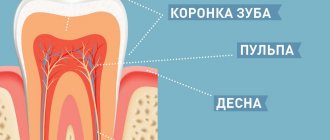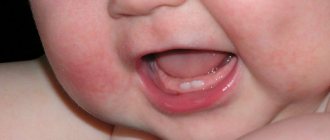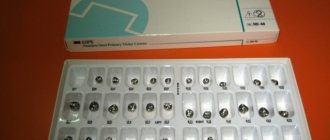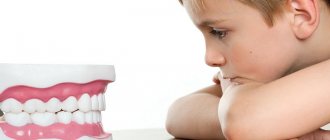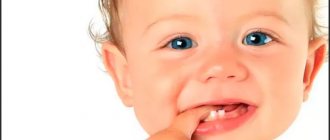A small child's jaw can only accommodate 20 baby teeth, and all of them must appear before the age of two . Over time, the size of the jaw will increase. And when the baby turns five or six, the tops of the first molars, called “sixes,” will appear along its edges.
At the same moment, the child’s baby teeth will begin to fall out, which will follow the same pattern as teething. But the process will last longer: permanent teeth will replace temporary ones only after six to seven years. And the remaining two pairs of molars, which should be the last in the row, will grow only by the age of 13.
How teeth are replaced and formed
When children lose their baby teeth, it doesn't hurt. Many are even happy to help the crown part with the gum, brag about the next loss to friends and eagerly wait for the next one to wobble in order to lure a gift from the Tooth Fairy.
Temporary incisors and canines have roots, but they are resorbed long before permanent teeth begin to grow. Therefore, at the right moment, the milk jugs lose their fastenings, become loose and fall out freely. But their “replacers” are structured differently.
Molars, molars and canines have a denser structure, strong roots, sensitive nerves, hard enamel and excellent endurance. They may slowly and painfully deteriorate, but they do not fall out. At least as easy as their predecessors.
Diagram: what baby and permanent teeth look like in children
Temporary teeth are formed even before birth - between the fourth and fifth weeks of fetal development. The molars are formed later, but their rudiments are formed even at the moment when the child is in the womb. Therefore, during pregnancy, the expectant mother should eat well. Increase the amount of cottage cheese, milk, cabbage, shrimp, nuts and other foods rich in calcium.
During the eruption of the first teeth, bone tissue continues to grow. The baby no longer receives useful elements from breast milk, so it’s time to introduce complementary foods into his diet. Now the child needs calcium more than ever before . After all, baby teeth will soon be replaced by permanent ones. And even then, the importance of the element entering the child’s body will not decrease, since the enamel will form over many more years and even into adolescence.
Attention! Temporary teeth affected by caries must be treated. The infection can spread to the molar buds, which will grow in the place of the patient. For the same reason, you need to teach your baby hygiene from the first year of life. And it is advisable to control this process so that it is carried out properly.
If it happens too late
According to dentists, the delay in the loss of temporary incisors is not so bad. The reason for this may be the following factors:
- heredity;
- severe diseases of infectious etiology suffered in childhood;
- chronic digestive disorder;
- lack of calcium and vitamins in the child’s body;
- rickets suffered in infancy;
- hereditary disorder of amino acid metabolism - phenylketonuria.
If the process of loss has not begun by the age of eight, you should consult a dentist. There is a possibility that the rudiments of permanent crowns are located too deeply or are completely absent.
How teeth fall out: signs
To predict when baby teeth will begin to change to permanent ones, you need to watch for several signs:
- Expansion of interdental spaces. Due to age-related enlargement of the jaw, primary incisors, molars and canines move away from each other. If this does not happen for a long time, the molars will grow crooked due to lack of space. An orthodontist can help solve the problem. He will take a picture of the jaw and check if the baby has an abnormality.
Photo: baby tooth does not give way to permanent toothBy pecking the permanent central incisor next to the temporary one. A molar may emerge from underneath the gum tissue before its predecessor falls out. If the process of changing your teeth does not improve within three months, you should contact the clinic as soon as possible . The baby may develop such an anomaly as “shark teeth” (see the photo for what the defect looks like). It is fraught with the formation of a curved row, malocclusion and requires immediate surgical intervention.
- Loose crown. Temporary roots begin to dissolve 12 months before permanent teeth emerge. When the process reaches the neck of the “young”, its upper part becomes loose and falls out.
Rules of conduct and precautions
Although baby teeth are called temporary, their condition and replacement pattern greatly affects the permanent teeth. Therefore, children are taught to care for them from an early age.
The basic rules will be:
- up to 1.5 years, the mother takes care of the oral cavity: morning toileting is performed with a special brush, which is placed on the mother’s finger;
- later the baby is taught to clean himself, using special children's pastes;
- from 2 years of age, it is recommended to perform a hygiene ritual twice: in the morning and in the evening, and additionally rinse the mouth after each meal;
- control the amount of carbohydrates and sweets in your diet;
- visits to the dentist should become a regular preventive measure, starting from two years of age;
- Keep baby dishes and pacifiers clean. The habit of licking a baby's spoon or pacifier causes bacteria from the mother's saliva to enter the baby's oral cavity;
- Before going to bed, drink only water.
Before they fall out, the incisors become noticeably loose, and children often begin to worry whether they will be able to eat. Don’t laugh at children’s fears; on the contrary, encourage your child to ask questions and answer them calmly. Form in your older preschooler an attitude towards the process of changing teeth as a sign of growing up. If food really begins to cause difficulties, then make changes to your diet. Prepare something softer: cream soup, mashed potatoes, steamed cutlets.
If there is a fear of swallowing your own tooth, then say that there is nothing dangerous in it: it is similar to swallowing a cherry pit.
Both five- and six-year-olds are very interested in everything that happens to them, so most of them touch a loose tooth with their fingers and tongue. Prohibiting in this case is not a solution, since the child can do this when you are not looking. Explain that any manipulations in the mouth are performed with clean hands and allow, as far as is reasonable, to examine the processes occurring in the mouth.
There is no need to force the process of falling out, but if the tooth gives the child anxiety or hurts while eating, then it may be better to have it examined and removed by a dentist.
If everything happened by itself, then the actions will be as follows:
- rinse your mouth with clean water;
- apply a clean cotton swab or gauze to the hole if blood comes out of the wound;
- no need to wipe the area on the gum with antiseptic solutions (chlorhexidine, peroxide, etc.);
- It is better to abstain from food for an hour and a half after removal;
- Explain to your child that you should not touch the hole with your fingers to avoid infection.
Which teeth change and which grow from scratch?
All milk jugs, of which there should be exactly 10 pieces on each jaw, fall out to give way to permanent ones. “Four” and “five” - the units that many call radical also drop out. But teeth that erupted instead of molars will be called premolars.
A child's first molars grow a year before baby teeth begin to fall out. They occupy free areas of the jaw, which appeared as a result of its age-related increase. And they are the sixth in a row. The latter will appear only at the age of 13, when the entire time series will be replaced by a constant one.
The order of arrangement of teeth in the oral cavity
A person's complete set of teeth should consist of 32 units. But the last four may appear only at the age of 16 or 20, and in some people they will never appear and remain as a rudiment in the gum. There is no need to worry about missing wisdom teeth or third molars, as this is normal.
What should parents do?
If a baby's crown falls out, parents should follow these recommendations:
- If painful sensations occur in young children, you can use the homeopathic remedy Dentokind. It helps eliminate swelling, relieve inflammation and reduce pain.
- The process of tooth loss is accompanied by the formation of a small wound in its place.
If it bleeds, parents should make a small swab from a sterile bandage and place it over the wound. The child needs to gently bite the tampon and wait 3-5 minutes. Often during this time the bleeding stops. If blood continues to ooze within 10-15 minutes after the tooth falls out, you should seek help from a dentist. - For antiseptic treatment of the wound, it is recommended to use a saline solution to which add a couple of drops of iodine.
- In case of severe pain and inflammation, the use of local painkillers is allowed after consultation with a dentist.
- You should not eat for two hours after a temporary tooth falls out.
In addition, it is advisable to temporarily limit the intake of irritating foods. This includes foods and drinks that are too hot, sour, spicy and salty. Such food can cause additional damage to the affected area. You should also avoid solid foods: nuts or crackers, so as not to injure the socket. - If you experience severe pain, inflammation of the gums at the site of the wound, swelling and itching, you should immediately consult a dentist.
In what order do teeth fall out: diagram
The sequence of teeth changes may vary from person to person. But usually the milkmen drop out in order:
- At five years of age, resorption of the roots of the central incisors begins. A little later - the side ones. And in six - the first molars. The process of separating the crown from the base lasts about 24 months.
- Loss of baby teeth begins in children from the age of six. First, a pair of lower central incisors leaves the gum, and a little later the “namesakes” on top.
Diagram: sequence of eruption and loss of baby teeth
- At seven or eight, the lateral incisors change. But unlike the central ones, in the reverse order: first the upper ones, and then the lower ones. By the age of nine, the child should have all 8 permanent incisors.
- At ten, the first molars - paired chewing teeth - change. In their place, molar premolars peck. But not immediately, but only by the age of twelve.
- At the age of eight, children begin to lose their third milk teeth - fangs, which are designed for tearing food into small pieces. Their permanent successors will begin to cut themselves at nine, and by ten they will decorate both jaws.
- At eleven, the teenager becomes the owner of first and second premolars. At about 12 years of age, a child has only permanent teeth left.
- The last to be cut are the large molars, which have another name - “sevens”. They appear first on the lower jaw, then on the upper jaw. “Wisdom teeth” grow after adulthood or do not appear at all.
What not to do
If one of the teeth is found to be loose, parents should explain to the child that it will soon fall out and a stronger one will grow in its place. In addition, it is important to tell the child that the crown should fall out on its own; it should not be artificially loosened, since premature loss can lead to problems with the structure of the jaw row.
In addition, after a crown falls out, you cannot perform the following actions:
- touch the resulting wound with your hands or tongue to avoid accidental infection;
- treat the wound with hydrogen peroxide or alcohol solutions, which can cause burns to the mucous membrane.
You will learn about all the advantages and disadvantages of dental fluoridation in children. We will talk about this in a specially prepared review. By clicking on the following link: https://dentist-pro.ru/detskaya-stomatologiya/d-zuby/prorezyvanie/gel-dlya-desen.html - you can read reviews about gels for teething gums.
And here you will learn how to use Vinilin for stomatitis in children.
When and why do children's teeth change?
The baby is born toothless because he has nothing to chew. In the first days of life, a baby's diet consists only of mother's milk. But already before birth, root rudiments form in the bone tissue of the fetal jaw. The first tooth erupts around the time the baby reaches the sixth month. At this age, he is ready to eat more solid foods.
At 3 years old, the child has all the baby teeth in his mouth. They appear in a certain sequence: first the incisors for biting, then the chewing molars, and only then the canines for grinding solid food.
As a person gets older, his jaw also increases in size. If in childhood there were only 20 teeth on it, then by adolescence their number increased to 32. Therefore, children's milk teeth begin to change to permanent ones. In addition, with age, a person needs a stronger enamel structure, as his diet becomes more varied and tougher.
Physiology of the process
The formation of baby tooth buds occurs while the baby is in the womb. After his birth, the process of their eruption and growth begins. As a child grows and develops, the size of his jaws and, accordingly, the interdental spaces increase.
At this time, the formation of the rudiments of permanent or radical elements of the jaw row occurs. This leads to gradual resorption of the roots of the milk crowns. Under the influence of eating solid food, a tooth with a shortened or missing root begins to loosen. Over time, it falls out, making room for the permanent one.
At what age do children’s teeth change: table
Up to 48 months, primary incisors and canines do not fall out or become loose . Unsteadiness is a sign of a lack of vitamins or a disease. If you contact your dentist in time, he will install an artificial implant that will help protect the integrity of the row.
Long-term absence of molars indicates an anomaly. You will have to take an x-ray, which will identify the developing disease and eliminate it at an early stage.
There are also opposite situations. When the milkman is in no hurry to give way to a permanent tooth that has already formed and begun to erupt. Such an obstacle must be removed to avoid improper growth of the molar.
It is impossible to give a clear answer to the question at what age do baby teeth change in different children. For some, the process will be completed by the age of ten, and for others only by thirteen. And both children will develop within normal limits. So there’s no need to worry about the fact that your peers are already smiling at 28 “pearls”, and your child is only 20. But if the delay is too long, it is still advisable to go to the doctor. And to find out whether the teeth are keeping up with the schedule, the table will help:
| Name of the pair (top and bottom) | Duration of baby tooth loss (age in years) | Period of eruption of permanent teeth (age in years) |
| First molars | ꟷ | 5–6 |
| Central incisors | 6–7 | 6–8 |
| Lateral incisors | 7–9 | 8–10 |
| Small temporary molars, after replacement – premolars | 8–10 | 10–12 |
| Large temporary molars, after replacement - premolars | 11–13 | 10–12 |
| Fangs | 9–11 | 10–12 |
| Second molars | ꟷ | 12–13 |
| "Wisdom teeth" | ꟷ | 17–20 |
Oral diseases
06/19/2018 admin Comments No comments
The child’s skull before the loss of baby teeth consists of a double dentition
Have you ever wondered what a child's skull looks like before losing baby teeth? When the stage of replacement of primary teeth with molars begins, a “naked” illustration of the child’s maxillofacial system can terrify parents. If you look deeper into an x-ray of a child's facial skeleton, the bulk of his jaw consists of a double row of teeth. Why is this happening? We'll find out more about this later.
Read also: Chamomile for toothache
What to do if the milk jug falls out prematurely
In childhood, you can lose a tooth due to a simple fall. The roots of primary teeth are weak and thin. Therefore, situations such as “got it from a friend with a shovel,” “landed unsuccessfully from a hill,” or “stumbled in the sandbox” often lead to the loss of a dental unit.
When the gum is empty, there is less pressure on it as the child tries to eat on the other side. As a result, the bone tissue begins to dry out, and neighboring roots move closer together. This process can lead to uneven growth of the permanent tooth and pathological changes in the formation of the jaw. And this is fraught not only with impaired chewing function, but also with the development of problems with digestion and facial muscles.
The situation can be easily resolved if you pay attention to it in time. You just need to go to the dentist and install a special expander in the interdental cavity, which will keep the adjacent teeth at the required distance until the replacement period begins.
Why does this happen at the wrong time?
In some cases, the process of loss of milk crowns may be ahead of the theoretically expected time limits or, conversely, behind them.
The reasons for untimely change include the following factors:
- genetic predisposition;
- incorrectly selected diet;
- deficiency of certain vitamins and minerals;
- poor quality of drinking water;
- pathologies in the formation of the rudiments of permanent teeth.
If there is a significant delay in the loss of primary teeth, the cause may be problems with the endocrine system or a chronic infectious disease.
We will talk in detail about how cutting the frenulum under the tongue in children with a laser occurs and what the recovery period involves. And here you will find the main symptoms and learn how to treat catarrhal stomatitis.
Why didn't my baby tooth fall out?
Late changes in the dentition should not always be considered a sign of pathology. Often the reason for the delay lies in a banal lack of vitamins. This phenomenon should not be ignored, but there is no need to panic. It is enough to contact your pediatrician and consult about vitamin and mineral complexes that can be given to your child based on his age and health status.
If the baby is eight years old and the baby teeth have not yet been replaced by molars, this is an alarming signal. There is a possibility that their rudiments have not even begun to form in bone tissue. But before you rush to conclusions, you should consult a doctor and take a panoramic photo of your jaw. It will help you see how serious the problem is.
The most common pathologies that cause a delay in the loss of children's primary teeth are:
- rickets;
- genetic abnormalities;
- infectious diseases;
- dyspepsia – disturbance of the stomach;
- phenylketonuria is a hereditary disease that is associated with impaired amino acid metabolism.
Pathologies in which a child’s baby teeth do not change are rare. But it’s better to play it safe and go to the doctor. After all, the stage of eruption of permanent teeth is the most important, since it is the last. And dental procedures, even super-promising ones, are very expensive. Especially when it comes to serious defects.
Possible deviations from the diagram
Deviations from the dropout pattern can occur in two directions: the start of the process too early or, conversely, a delay. Premature onset of events compared to the usual pattern can be triggered by:
- poisoning with salts or mercury;
- lack of vitamins, especially C;
- diabetes mellitus;
- metabolic abnormalities;
- immunodeficiency states.
Factors that accelerate the process can be injury or caries. Moreover, caries is much more dangerous for children than for adults, because the tooth enamel in children is noticeably thinner. To protect teeth from destruction and stop the carious process, a silvering procedure is carried out. It is recommended if caries appears in a 2-3 year old child, since it is difficult to carry out conventional treatment in such a small child.
As a preventative strengthening agent, a fluoridation procedure is recommended. It can be done for both children and adults to increase the resistance of enamel to external influences. You can start fluoridation as early as 1.5-2 years.
Such a violation of the scheme as a delay in deadlines is much less common. The cause may be: general delay in mental and biological development, various infectious diseases, rickets, prolonged stressful situations, nutritional disorders and lack of necessary substances.
If by age 7 the baby teeth are still complete, then you should take your child for a dental examination. Your doctor may recommend taking an X-ray to check for tooth germs in your jaws.
FAQ
Parents often have controversial questions regarding the replacement of baby teeth.
This is often caused by the presence of diseased teeth, which you want to quickly replace with strong, healthy ones. In this regard, it is possible to succinctly summarize the important information regarding primary and molar teeth. Read also: Mouthguard for teeth at night Are all baby teeth replaced by molars (permanent)?
Yes all. The process of changing teeth is quite long, but all milk teeth will be replaced by permanent ones. In addition, at least four more molars will be added to them. The entire process of tooth growth should be completed by the age of 12-14 years. The remaining four wisdom teeth may grow throughout your life or may not grow at all.
The photo shows the change of teeth in a child
How many baby teeth do children lose?
Children lose 20 baby teeth: eight incisors, four canines and eight molars. They differ significantly from permanent ones, as they are less bumpy. In addition, baby teeth have wider roots, since they are a protective block for the developing permanent ones.
Which teeth fall out first?
The first to fall out are the central incisors, and they can fall out both above and below; more often, the lower ones begin to fall out. Then - lateral incisors, canines and molars. The latter after the change are called premolars. In general, the pattern of tooth loss and growth is approximately the same as during the eruption of milk teeth.
An orthodontist will talk about how children's teeth change in this video.
What problems can pathology cause?
The main problems may be related to aesthetics (small crown size) and supporting function (short roots). But this is not all the complications that the presence of milk units in the permanent dentition can lead to: they can interfere with the growth of the permanent ones, cause malocclusion, and provoke incorrect placement of “neighbors.” This situation can cause you a lot of inconvenience, ranging from the inability to fully eat and chew food, ending with aesthetic defects, impaired sound pronunciation, difficulty in hygienic care, and, as a result, the appearance of various dental diseases.



